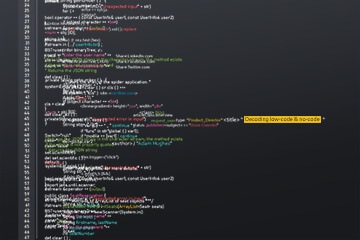Decoding low-code & no-code

Hi Brian. There’s lots of hype around low-code and no-code – what’s all the excitement about?
Low-code and no-code are tools that allow you to rapidly create or alter software applications without having to be an expert developer. Low-code gives you the ability to add scripting or coding solutions on top, while no-code is purely a graphical process.
So it’s just a new name for a GUI then?
[Laughing] In a way I suppose so, yes, but then you could describe most things as that, really.
If you trawl back through the history of computers, it has been a constant iteration of putting layers on top of the binary code that ultimately runs – this is the latest evolution of that. For example, prior to graphical operating systems, you controlled what the computer did via command prompt. Adding the GUI allowed less technical people to access the same functionality. No-code is all about doing the same thing, but for the process of creating new programs or functions themselves.
It’s only of interest to programmers then?
Not at all. Low-code platforms give even the most seasoned developers shortcuts to creating and augmenting things faster, but no-code platforms are very much aimed at business users, allowing them to create applications from scratch without having to understand anything about programming.
The focus for us has always been on providing a highly configurable product to try and put the ownership back in to the business. You get that market agility with these no-code abilities.
Can you give me a few examples?
Take the gaming world; on PlayStation, you have LittleBigPlanet. More than a game, it’s a no-code game creation platform. Using just your controller, you can place items with pre-determined properties on the playfield in any way you want and assign pre-created actions and logic to them (move, jump, shoot etc.) to create your own game, with no programming knowledge.
Minecraft on PC, on the other hand, is an example of low-code; while you can do similar things with the game’s default assets, you can also add your own Java programs to augment and create actions that weren’t previously possible.
It also highlights an important point – that a low-code platform can be a no-code platform for a lot of users, letting them create up to a certain point, but if they want to expand the boundaries, a developer would have to get involved.
Ok, I think I’m getting it, but how does this relate to BSS/OSS?
In the BSS/OSS world, or indeed any enterprise application, we have of course had elements of this for a while now. In most systems it’s been a long time since you had to go back to your vendor for them to make software changes before you could launch a new product (if you still do, please get in touch!); there will usually be a product catalogue of one sort or another that allows you to create new products graphically within the rules of the system provided.
When we talk about low-code or no-code, we are really talking about enabling what should be everyday changes to reflect new business process or commercial offers within the BSS, and all done in a way that doesn’t need IT skillsets and doesn’t require a redeployment of software.
How does Cerillion support low-code or no-code?
In many ways, and we’re constantly expanding them – in fact, our ethos has always been configuration not customisation.
To give you a recent example, using our Business Insights analytics module, you can create any type of responsive or predictive dashboards and workspaces, add ‘cards’ to existing pages, and create links back and forth with other modules. For most people, this is a no-code platform, however you can also add JavaScript to any of these to create new visualisations we haven’t thought of or add extra controls, so technically, it’s also low-code.
Another example is CRM Plus, which gives you complete control over the layout of pages: adding, moving, and removing fields as you see fit; adding your own business rules and validations, images, instructions for your users, and so on. Tables can similarly be controlled, adding, and removing columns, ordering, sizes, etc. These are all things that traditionally would have required a change request and code changes that can now be done with no-code by admin users.
If something sounds too good to be true, it usually is – what’s the catch?
Well, low-code / no-code is all about flexibility, and putting that flexibility into the hands of the business user. But with flexibility comes responsibility and the need for increased governance and configuration management. If companies can now easily build or change the behaviour of their applications, they also need a process in place to manage and document those changes to ensure they can be maintained. The last thing a business needs is to try and unpick what low-code / no-code changes have been made after the expert has left the company.
Furthermore, managing these applications requires an additional layer of internal support to identify if problems are caused by low-code / no-code changes or in the underlying vendor software.
Thanks Brian, some very useful insights and advice. We look forward to hearing more about the latest low-code / no-code developments in the future.

